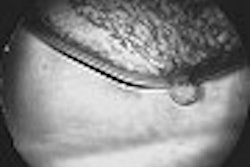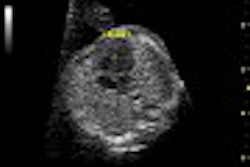(Ultrasound Review) The objective of a recent article published in Journal of Ultrasound in Medicine was to determine the impact of tissue harmonic imaging (THI) on the visualization of focal breast lesions.
According to Dr. Kazimierz Szopinski and colleagues, "tissue harmonic imaging improved the grayscale contrast between the fatty tissue and breast lesions in 90.6% of lesions compared with fundamental frequency images." Lesion detection and characterization was definitely improved using THI. They found conflicting results in 24 lesions (9.4%) when the contrast was reduced using THI compared with fundamental grayscale.
Their prospective study of 219 women with 254 focal breast lesions detected "23 breast carcinomas, six suspect lesions, nine fibroadenomas, one papilloma, one phyllodes tumor, 162 unspecified solid benign lesions, and 40 cysts."
Graphical software (Adobe Photoshop) was used to measure grayscale, which determined the contrast between breast lesions and surrounding fat. They discovered that contrast improvements were greater in women with mainly fatty or mixed fatty and glandular tissue compared with women that had predominantly glandular tissue.
Ultrasound imaging was performed using a linear array transducer with a fundamental frequency of 7.5 MHz, and THI frequency of 3.4 MHz. Using ultrasound guidance, fine-needle aspirations were performed for cytologic analysis using 22- or 23-gauge needles. Digitally stored images were independently reviewed by three radiologists who compared fundamental and harmonic images.
The authors concluded that THI increased the conspicuity of focal breast lesions compared with adjacent fat. "The overall conspicuity, border definition, and content definition are better or equal in the harmonic mode in all lesions. Tissue harmonic imaging enhances acoustic shadows, which are important sonographic signs," they asserted.
Due to posterior shadowing from the Cooper ligaments, they recommended an initial breast survey without harmonics. "Tissue harmonic imaging may prove a valuable addition to conventional sonographic examinations of the breast, improving lesion visualization, and may be a problem-solving tool when studying suspect lesions or areas in the breast," they concluded.
Tissue harmonic imaging: utility in breast sonographySzopinski, K. T. et. al.
Department of diagnostic imaging, second faculty of medicine, Medical University of Warsaw, Poland
J Ultrasound Med 2002 May; 22:479-487
By Ultrasound Review
July 30, 2003
Copyright © 2003 AuntMinnie.com



















